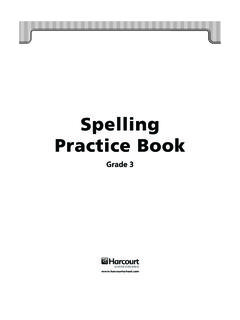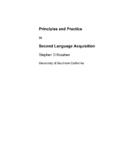Transcription of Teaching Academic Vocabulary - altonschools.org
1 Marzano's Six Step Process Teaching Academic Vocabulary 1. Provide a description, explanation, or example of the new term. (Include a non-linguistic representation of the term for ESL kids.). 2. Ask students to restate the description, explanation, or example in their own words. (Allow students whose primary existing knowledge base is still in their native language to write in it.). 3. Ask students to construct a picture, symbol, or graphic representing the word. 4. Engage students periodically in activities that help them add to their knowledge of the terms in their notebooks.
2 5. Periodically ask students to discuss the terms with one another. (Allow in native language when appropriate). 6. Involve students periodically in games that allow them to play with terms. 1. Provide a description, explanation, or example of the new term. Looking up words in dictionaries is not useful for Teaching vocab Provide a context for the term Introduce direct experiences that provide examples of the term Tell a story that integrates the term Use video as the stimulus for understanding information Ask students to investigate the term and present the information to the class (skit, pantomime, poster, etc.)
3 Describe your own mental picture of the term Find or create pictures that explain the term 2. Ask students to restate the description, explanation, or example in their own words. Monitor and correct misunderstandings Must be student's original ideas, not parroting the teacher 3. Ask students to construct a picture, symbol, or graphic representing the word. Model, model, model Provide examples of student's drawings (and your own) that are rough but represent the ideas Play Pictionary . Draw an example of the term Dramatize the term using speech bubbles Let them find a picture on the internet, if necessary 4.
4 Engage students periodically in activities that help them add to their knowledge of the terms in their notebooks. Highlight prefixes, suffixes, root words that will help them remember the meaning of the term Identify synonyms and antonyms for the term List related words Write brief cautions or reminders of common confusions Translate the term into another language for second language students Point out cognates to words in Spanish Write incomplete analogies for students to complete Allow students to write (or draw) their own analogies Sort or classify words Compare similarities and differences 5.
5 Periodically ask students to discuss the terms with one another. Think-Pair-Share Compare their descriptions of the term Describe their pictures to one another Explain to each other any new information they have learned ( aha's ). Identify areas of disagreement or confusion and seek clarification Students can make revisions to their own work 6. Involve students periodically in games that allow them to play with terms. Pictionary Oops (formerly known as Bang ). Upset the fruit basket Memory Jeopardy (vocab words are on the board, players make up a question to define).
6 Charades Name that Category ($100,000 Pyramid). Password Talk a Mile a Minute (like Catch Phrase). Bingo (you give definition, kid marks the word). Create a skit (assign groups of 3-4 kids 3 vocab words to make a skit out of). Swat Game (post 2 sets of words, kids on 2 teams compete to find words first and swat with fly-swatter). BEFORE you begin your next UNIT of INSTRUCTION: 1. What Power Indicators (standards) are included in this Unit? List indicators. - - - 2. What is the key Academic Vocabulary needed in this Unit? List words.
7 - - - - - - Plan for direct vocab. instruction: (Marzano's 6 Steps for Teaching Vocab.). 1. YOU provide a description, explanation or example. (story, sketch, powerpoint). 2. Ask students to re-state or re-explain meaning in their own words. (journal, community circle, turn to your neighbor). 3. Ask students to construct a picture, graphic, or symbol for each word. 4. Engage students in activities to expand their word knowledge. (add to their notes, use graphic organizer format). 5. Ask students to discuss Vocabulary words with one another.
8 (collaborate). 6. Have student play games with the words. (Bingo w/definitions, Pictionary Charades, ). 3. Plan to provide or activate background knowledge: __ Study Trip __ Guest Speaker (expert). __ Bring In Live Sample __ Bring In Actual Artifacts __ Theme Day ( Indian Day ). __ Video (United Streaming) __ Show Photos __ Posters __ Models of Actual Items __ Graphic Organizer __ PowerPoint __ Community Circle Topic __ Read Aloud (story). __ Other 4. Now you are ready to plan your Unit's lessons, activities, and assessments.
9 Vocabulary Four Square _____. _____. _____. Meaning Picture _____. _____. _____. Word Sentence Word Picture _____. _____. _____. _____. Synonym _____. Antonym In my own words: _____. _____. Sentence _____. _____. Word Picture _____. _____. _____. _____. Synonym _____. Antonym In my own words: _____. _____. Sentence _____. _____. Connect Two Choose two words from your list. Describe to your partner or group how those two words are related. You all need to write how they are connected. Then your partner can choose two other words.
10 Example: _____Courteous_____ and ___drenched____. are connected because a courteous person will share his umbrella so someone doesn't get _____and _____. are connected because _____. _____. _____. _____and _____. are connected because _____. _____. _____. YES. ! NO. Word Context Clue Definition Quick Draw Connection WEBSITES. Article on using student friendly definitions versus typical dictionary definitions. df?x-r=pcfile_d This article discusses what it means to learn Vocabulary and also a few ways promote Vocabulary acquisition .







